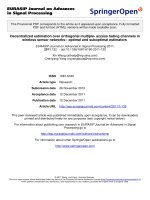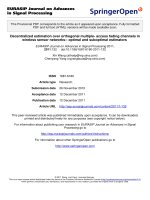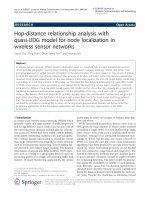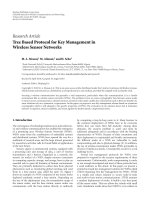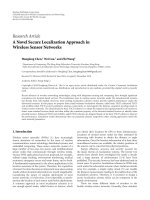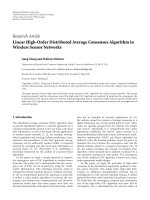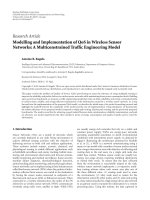Machine learning based congestion control in wireless sensor networks
Bạn đang xem bản rút gọn của tài liệu. Xem và tải ngay bản đầy đủ của tài liệu tại đây (1.04 MB, 108 trang )
MACHINE LEARNING BASED CONGESTION
CONTROL IN WIRELESS SENSOR NETWORKS
JEAN-YVES SAOSENG
NATIONAL UNIVERSITY OF SINGAPORE
2007
MACHINE LEARNING BASED CONGESTION CONTROL IN
WIRELESS SENSOR NETWORKS
JEAN-YVES SAOSENG
(B. Eng. , Supelec, France)
A THESIS SUBMITTED
FOR THE DEGREE OF MASTER OF ENGINEERING
DEPARTMENT OF ELECTRICAL & COMPUTER ENGINEERING
NATIONAL UNIVERSITY OF SINGAPORE
2007
Acknowledgments
I would like to express my gratitude to my supervisor, family members and friends who
have helped me in one way or another during my study at NUS.
First, I would like to thank my supervisor, Dr Tham Chen Khong, for his direction
and guidance given to me during the course of the project. He has been a source of
motivation and encouragement in the course of this undertaking.
My warmest thanks to Computer Networks and Distributed Systems Laboratory
members and its officer, Mr. Eric Poon, in making the laboratory such a nice place to
work.
My study at National University of Singapore was made possible through graduate
research scholarships. I am extremely thankful to NUS for the financial support.
April 11, 2007
i
Contents
1 Introduction
1
1.1
Background on wireless sensor networks . . . . . . . . . . . . . . . . . .
1
1.2
Motivation and objectives of the research . . . . . . . . . . . . . . . . .
2
1.3
Main contributions . . . . . . . . . . . . . . . . . . . . . . . . . . . . . .
3
1.4
Structure of the Thesis . . . . . . . . . . . . . . . . . . . . . . . . . . . .
4
2 Literature review
2.1
2.2
2.3
2.4
5
Introduction . . . . . . . . . . . . . . . . . . . . . . . . . . . . . . . . . .
5
2.1.1
Congestion in sensor networks
. . . . . . . . . . . . . . . . . . .
5
2.1.2
Design criteria in congestion control . . . . . . . . . . . . . . . .
6
Congestion Avoidance . . . . . . . . . . . . . . . . . . . . . . . . . . . .
9
2.2.1
Congestion Detection . . . . . . . . . . . . . . . . . . . . . . . .
9
2.2.2
Congestion Notification . . . . . . . . . . . . . . . . . . . . . . .
11
2.2.3
Rate Control . . . . . . . . . . . . . . . . . . . . . . . . . . . . .
13
Congestion Control . . . . . . . . . . . . . . . . . . . . . . . . . . . . . .
16
2.3.1
Traffic shaping . . . . . . . . . . . . . . . . . . . . . . . . . . . .
17
2.3.2
Queue Management . . . . . . . . . . . . . . . . . . . . . . . . .
17
2.3.3
Adaptive Routing . . . . . . . . . . . . . . . . . . . . . . . . . .
18
Conclusion
. . . . . . . . . . . . . . . . . . . . . . . . . . . . . . . . . .
ii
19
3 Link Flow Control Problem
20
3.1
Problem Statement . . . . . . . . . . . . . . . . . . . . . . . . . . . . . .
20
3.2
Agent Model of the sensor node . . . . . . . . . . . . . . . . . . . . . . .
23
3.3
Actions of the Packet Handler . . . . . . . . . . . . . . . . . . . . . . . .
24
3.3.1
Contention Regulation . . . . . . . . . . . . . . . . . . . . . . . .
25
3.3.2
Rate Regulation . . . . . . . . . . . . . . . . . . . . . . . . . . .
26
3.4
Network State Monitor . . . . . . . . . . . . . . . . . . . . . . . . . . . .
28
3.5
Conclusion
30
. . . . . . . . . . . . . . . . . . . . . . . . . . . . . . . . . .
4 Adapting Policies by Reinforcement Learning
32
4.1
Introduction . . . . . . . . . . . . . . . . . . . . . . . . . . . . . . . . . .
32
4.2
Background on Reinforcement learning . . . . . . . . . . . . . . . . . . .
33
4.2.1
SMART reinforcement learning . . . . . . . . . . . . . . . . . . .
34
4.2.2
Distributed reinforcement learning in cooperative systems . . . .
36
Reinforcement Learning for congestion control . . . . . . . . . . . . . . .
37
4.3.1
Reinforcement Learning of Contention Window Policy (RLCW) .
38
4.3.2
Reinforcement Learning of Rate Policy (RLRATE) . . . . . . . .
42
4.3.3
Implementation issues . . . . . . . . . . . . . . . . . . . . . . . .
45
4.3
4.4
Conclusion
. . . . . . . . . . . . . . . . . . . . . . . . . . . . . . . . . .
5 Distributed Coordination using Inference
46
48
5.1
Introduction . . . . . . . . . . . . . . . . . . . . . . . . . . . . . . . . . .
48
5.2
Belief Propagation . . . . . . . . . . . . . . . . . . . . . . . . . . . . . .
49
5.3
Definition of Potential Functions . . . . . . . . . . . . . . . . . . . . . .
52
5.3.1
Coordination Graph . . . . . . . . . . . . . . . . . . . . . . . . .
52
5.3.2
Coordination of Contention Windows (COCW) . . . . . . . . . .
53
5.3.3
Coordination of packet generation rates (CORATE) . . . . . . .
57
5.3.4
Implementation issues . . . . . . . . . . . . . . . . . . . . . . . .
60
iii
5.4
Conclusion
. . . . . . . . . . . . . . . . . . . . . . . . . . . . . . . . . .
6 Simulations and Results
6.1
6.2
6.3
6.4
61
63
Model of wireless sensor network . . . . . . . . . . . . . . . . . . . . . .
65
6.1.1
Simulation parameters . . . . . . . . . . . . . . . . . . . . . . . .
65
6.1.2
Performance evaluation . . . . . . . . . . . . . . . . . . . . . . .
66
Non-periodic workload scenario
. . . . . . . . . . . . . . . . . . . . . .
67
6.2.1
Results of RLCW and COCW . . . . . . . . . . . . . . . . . . .
68
6.2.2
Analysis of the value functions and learned policy . . . . . . . .
71
Periodic workload scenario . . . . . . . . . . . . . . . . . . . . . . . . . .
74
6.3.1
Results of RLRATE and CORATE . . . . . . . . . . . . . . . . .
75
Discussion . . . . . . . . . . . . . . . . . . . . . . . . . . . . . . . . . .
80
7 Conclusions
84
7.1
Contributions . . . . . . . . . . . . . . . . . . . . . . . . . . . . . . . . .
84
7.2
Applications and Implementation . . . . . . . . . . . . . . . . . . . . . .
85
7.3
Future work . . . . . . . . . . . . . . . . . . . . . . . . . . . . . . . . . .
87
A Algorithms
88
A.1 SMART Algorithm . . . . . . . . . . . . . . . . . . . . . . . . . . . . . .
90
A.2 Min-Sum Algorithm . . . . . . . . . . . . . . . . . . . . . . . . . . . . .
92
iv
Summary
The performance of wireless sensor networks strongly depends on the underlying
transport protocol. The traffic characteristics in sensor networks are known to cause
frequent congestion spots. In this thesis, novel adaptive methods in congestion control
are explored.
In the first part of this thesis, a review of existing work in congestion control is given
to highlight the congestion likelihood problem. Two means of congestion mitigation are
employed depending on the sensing scenario. First, the regulation of channel contention
is proposed for mitigation of transient congestion. Second, the packet generation rate
is adjusted collaboratively to provide fairness and efficiency. Two artificial intelligence
methods are investigated to solve these control problems. A first solution based on reinforcement learning is proposed to learn the policy which minimizes packet drop and
unfairness. To this end, buffer overflows and greedy actions are punished with negative
rewards. The SMART algorithm is then applied to maximize the long term average
performance. The second solution is an inference technique called Min-Sum. The minimization of congestion is transformed into smaller coordination problems involving fewer
variables. The interactions between sensors nodes are modelled in order to coordinate
their control decisions.
The simulation results show that 15% improvement in energy efficiency is obtained
over the recently proposed Fusion method. With a non-periodic workload, the proposed
learning method provides privileged channel access to gateway nodes, making bandwidth
available for higher aggregate throughput. With a periodic workload, the proposed
v
method still outperforms Min-Sum and Fusion in both fairness and efficiency. Although
Min-Sum based methods allow accurate decision trade-offs, the message exchange is a
limiting factor in the correctness of decisions.
This thesis shows that the congestion controller can learn the policy and hence does
not require detection thresholds.
vi
Publication
Saoseng J.-Y. and Tham Chen-Khong, “Coordinated Rate Control in Wireless Sensor Networks”, accepted for 2006 IEEE International Conference on Communication
Systems (ICCS), Singapore, 30 Oct - 1 Nov 2006.
vii
List of Figures
2.1
Wireless sensor network with a congested node . . . . . . . . . . . . . .
7
3.1
Contention delay in congestion notification . . . . . . . . . . . . . . . .
22
3.2
Link Flow Control model . . . . . . . . . . . . . . . . . . . . . . . . . .
23
3.3
Regulation of the packet generation rate and transmission rate . . . . .
25
3.4
Flowchart of CSMA with back-offs . . . . . . . . . . . . . . . . . . . . .
26
3.5
Flowchart of a packet generation . . . . . . . . . . . . . . . . . . . . . .
27
3.6
Rate limitation with fairness indexes . . . . . . . . . . . . . . . . . . . .
30
4.1
Reinforcement learning model . . . . . . . . . . . . . . . . . . . . . . . .
33
4.2
Agents and Communications involved in RLCW. . . . . . . . . . . . . .
40
4.3
Agents and Communications involved in RLRATE.
. . . . . . . . . . .
43
5.1
An undirected graphical model with the potential functions . . . . . . .
50
5.2
The coordination graph over the spanning tree . . . . . . . . . . . . . .
53
5.3
Coordination between two adjacent sensor nodes . . . . . . . . . . . . .
55
5.4
Implicit message passings with the primary traffic
. . . . . . . . . . . .
59
6.1
Topology of the simulated wireless sensor network. . . . . . . . . . . . .
64
6.2
Total Packet drop in the network with non-periodic workload . . . . . .
68
6.3
Aggregate Throughput with non-periodic workload
. . . . . . . . . . .
69
6.4
Contention window chosen by sensor nodes at 1pps . . . . . . . . . . . .
71
viii
6.5
Energy efficiency with non-periodic workload . . . . . . . . . . . . . . .
72
6.6
Total energy spent in the network with non-periodic workload
. . . . .
72
6.7
Convergence of the value function and the policy . . . . . . . . . . . . .
73
6.8
Value function and Action learnt in RLCW as function of buffer occupancy qp . . . . . . . . . . . . . . . . . . . . . . . . . . . . . . . . . . . .
74
Total Packet drops in the network with periodic workload . . . . . . . .
76
6.10 Decisions taken by greedy node . . . . . . . . . . . . . . . . . . . . . . .
77
6.11 Network Fairness with periodic workload
. . . . . . . . . . . . . . . . .
78
6.12 Aggregate Throughput with periodic workload . . . . . . . . . . . . . .
78
6.13 Energy efficiency with periodic workload
79
6.9
ix
. . . . . . . . . . . . . . . . .
List of Tables
2.1
Summary of existing congestion control schemes in WSNs . . . . . . . .
19
4.1
Summary of the learning methods . . . . . . . . . . . . . . . . . . . . .
47
5.1
Summary of the coordination methods . . . . . . . . . . . . . . . . . . .
62
6.1
System parameters . . . . . . . . . . . . . . . . . . . . . . . . . . . . . .
64
6.2
Methods compared with non-periodic workload . . . . . . . . . . . . . .
67
6.3
Traffic forwarded by node . . . . . . . . . . . . . . . . . . . . . . . . . .
69
6.4
Methods compared with a periodic workload . . . . . . . . . . . . . . .
75
6.5
Summary of the studied methods . . . . . . . . . . . . . . . . . . . . . .
83
x
Chapter 1
Introduction
This chapter presents a brief overview of wireless sensor networks. The main objectives,
contributions and the thesis structure are then summarized.
1.1
Background on wireless sensor networks
A Wireless Sensor Network (WSN) [1] consists of small micro-electronic devices with
sensing, processing and communication capabilities. WSNs are intended to scale up
to thousand of nodes and to cover large geographical areas. Sensors are scattered in
the space of interest and then let to run with minimal human intervention. Wireless
sensor networks promise a wide range of new applications such as habitat monitoring
and target tracking.
Wireless communication suffers from radio interference, fading, high bit-error and
collisions. Besides, wireless sensors communicate with little power and relatively simple
protocols. Low energy consumption and reliable detection of the event are more significant attributes in WSNs. The packet is thus usually small and the transmission rates
can be lower than one packet per second. Several types of workload are distinguished:
event-driven, query-driven or periodic.
1
Applications running on wireless sensors have strict resource constraints. Sensor
nodes are provided with little processing capabilities, small memory and low bandwidth.
Moreover, they are often powered with batteries whose replacement is impractical. Since
the radio component consumes energy the most [1], the communication protocols have
to be energy efficient. For example, processing the data before transmitting can reduce
communication. Implementing a sleep schedule is another way to increase the lifetime
of the network.
The flows in WSNs are convergent and extend over multiple hops. One or several
sinks are used for data collection. The collection usually has the pattern of a tree rooted
at the sink. Intermediate nodes forward packets from the upstream branches towards
the sink. In a WSN, congestion spots are frequently located near the sink and at the
intersection of flows.
1.2
Motivation and objectives of the research
The channel is usually shared in WSNs and limited in capacity. Since the users of the
network assign arbitrary sensing rates, the total load can exceed the capacity of the
network. Therefore, congestion control is necessary to prevent packet drops. Wireless
transmissions cost in energy and bandwidth. The dropping of a packet waste not only
the last transmission but all the previous hops, hence diminishing the network energy
efficiency. A congested network is not only inefficient but unfair: Congested paths are
prone to packet loss. The network becomes unfair in presence of congestion because
shorter paths have higher delivery ratio than longer paths.
Recent work [2, 3] suggests a three phases process: detection of congestion then its
notification, followed by a rate adjustment. These methods entail two issues. First, the
notification of congestion suffers from a random delay in contention based communications. Second, these schemes do not consider that different parts of network are more
2
likely congested than others.
The objectives of this thesis are multiple:
• To introduce adaptive methods for congestion control. The detection and rate
adjustment parameters can be customized for a particular node to maximize the
effectiveness of the control.
• To evaluate their efficiency and fairness for various traffic workloads.
• To establish the coordination between sensor nodes. Data collection is a collaborative task in WSNs. A sensor node may benefit when coordinating with its peers
in order to mitigate congestion.
1.3
Main contributions
In this thesis, multi-agent technology is investigated to model the network of sensors,
while reinforcement learning and inference solutions to the congestion control problem
are explored. The agent controls either the transmission or the generation of data
packets to reduce congestion and unfairness.
Two methods are studied to adapt the control decisions to the each sensor node’s
context:
• A model free method approximates the control policy by reinforcement learning.
The control problem is represented as a Semi-Markov Decision Process (SMDP).
Based on a feedback, the agent learns the action that maximizes an utility function.
• The inference method coordinates the agents’ action to reach a global objective.
The congestion control problem is formulated as a cost minimization. The costs
are modelled with coordination functions. Messages are exchanged to determine
the minimal cost action in a decentralized way.
3
The simulation results showed that the proposed methods can improve the energy
efficiency up to 15% over the Fusion method[4] with periodic and non-periodic workload.
They also provide fair collection from all sources.
1.4
Structure of the Thesis
The remainder of this thesis is organized as follows:
The next chapter surveys congestion control and avoidance schemes in WSNs. Design
goals are also provided.
Chapter 3 presents the notification delay issue and its effect on congestion. The
problem is tackled with an approach intending to reduce loss and also with another for
fair allocation.
Chapter 4 gives introductory foundations to reinforcement learning. Then, the congestion control problem is translated as a learning problem where an agent is trying to
interact optimally with its environment and other agents.
Chapter 5 presents the inference algorithm Min-Sum for coordinating agents. The
theoretical background of the method is given, then interactions are modelled.
Chapter 6 presents the simulations and the results. Four proposed methods are
compared to existing methods on a 19-nodes network.
Finally, Chapter 7 concludes the thesis, highlighting the major contributions.
4
Chapter 2
Literature review
This chapter presents the state of the art in congestion control for wireless sensor
networks. The main design points of a congestion control scheme are laid out. The
existing methods can be classified in either congestion avoidance or congestion control.
Most of existing work combines several methods to increase both efficiency and fairness.
2.1
2.1.1
Introduction
Congestion in sensor networks
In wireless sensor scenarios, the sink is not always within direct transmission range. Intermediates nodes forward packets and also generate packets. The bandwidth allocation
is especially complex in a multi-hop ad-hoc network. Given that the channel capacity
is limited in capacity, sensor nodes must adapt their transmission and their packet generation rate. If the source nodes near the sink originate too much bandwidth, little is
left for distant nodes. Conversely, if the distant nodes originate important traffic, the
nodes downstream will drop packets by congestion, wasting the previous effort to forward them. Moreover, transient congestions are frequent in wireless networks, because
5
the channel condition varies with time.
Congestion also occurs when events are reported collectively. For example, sensors
tracking the same event will simultaneously create packets. The channel can become
congested since several nodes transmit within a very short period. The buffers eventually
overflow when the packets propagate in burst towards the sink.
Nodes near the sink send a lot of packets because they route the traffic from the
entire upstream spanning tree. Since each hop has a congestion probability, a path with
more hops suffers from more loss. Therefore congestion leads to unfairness. Distant
sources suffer from greater loss than closer sources whose packets are collected in larger
proportion.
Congestion control intends to limit the effects of congestion such as packet drops
and delay. A fair allocation of bandwidth is desirable as it ensures an uniform sensing
coverage. In WSNs, energy efficiency is important and few seconds of delays are tolerated
in most applications.
Physical errors can be the first cause of congestion [4]. Radio transmissions have
effects beyond the reception range. Two wireless sensors may not able to communicate
directly, but can mutually interfere each other as shown in Figure 2.1. Interferences lead
to high error and collision probability. Congestion collapse can occurs even with large
buffers since congestion may cause corrupted transmissions due to interferences.
2.1.2
Design criteria in congestion control
In WSNs, several criteria should be taken into consideration in the design of a congestion
control scheme:
1. Burst management: congestion occurs not only with a periodic workload, but also
with an event-based workload.
6
Figure 2.1: Wireless sensor network with a congested node. The transmission and
interference range are shown with circles.
2. Stable response: A fast detection and response to congestion permits more energy savings. However, with a random channel access, a delay is expected in the
propagation of control messages. The control system should avoid response to
temporary perturbation that could cause oscillation.
3. Load diversity: Since the report rate is specific to the application, the congestion
control scheme should give consistent performance in light and heavy load. If the
offered load exceeds the network capacity, the scheme must be able to minimize
congestion. In addition, some sources may be more important than others, thus
the scheme should distinguish the weight of packets.
4. Robust in imperfect wireless environment: Wireless links can lose up to 20% of
packets due to errors. Besides, topology changes can occur in real deployment.
5. Adaptability: Self configuration of the algorithm is an useful feature since sensors
7
are deployed in large numbers. The congestion control scheme may adapt to the
particular environment of a node.
6. Simple: The overhead induced by control signals or by processing is kept low in
order to not hinder the main application.
Finally, the scalability of the scheme must be indisputable.
Beside conventional quality of service metrics like drop rate, throughput and delay,
other design criteria are relevant to wireless sensor networks:
• Energy efficiency is essential since congestion affects the lifetime of the network.
Packet drops waste the energy spent in the previous hops. Collisions and channel errors are additional energy waste because of retransmissions. The efficiency
expressed in J/packet is proportional to the number of packets collected at the
sink.
• Fairness: The utility of the information collected is optimal when the delivery is
perfectly balanced. In a congested network, far sensor nodes deliver packets with
difficulty. As a result, fairness diminishes because the collected information mainly
comes from nodes next to the sink.
• Reliability: The application may define a minimum reliability which requires a
certain delivery ratio. This metric is also called the perceived application fidelity.
In general, sensing applications do not require end-to-end packet reliability since
the information is redundant.
In the sensor network literature, congestion control schemes differ in the way of detecting a congestion, of signaling it and in the way of adjusting the rates. Two congestion
8
control strategies exist: congestion control and congestion avoidance. A congestion control mechanism prevents abrupt congestion collapse by ensuring throughput and fairness
deteriorate gracefully with the load. Congestion avoidance techniques adjust the rates
after congestion is detected.
2.2
Congestion Avoidance
Congestion avoidance mechanisms have been reported since the development of MAC
protocols in sensor networks [2]. They were initially designed to improve the network
reliability, by preventing packet drops. New issues related to congestion were raised and
several techniques were proposed such as: buffer based detection, fair rate allocation
and prioritized channel access. Various types of rate adjustment are reported: heuristic, exact, or based on the current congestion level. This section presents the several
congestion indicators and the rate adjustment techniques frequently met in the WSN
literature.
2.2.1
Congestion Detection
Congestion detection is estimating the probability of packet loss or delay. In conjunction
with mitigation techniques, an accurate detection can anticipate a growing congestion
and prevent the overflows of buffers. The congestion indicators have an essential role to
avoid congestion. In addition, the rate adjustment can be dynamically adjusted according to the congestion levels to enhance response and stability.
Buffer occupancy is the prevalent congestion indicator [3, 4, 5, 6, 7, 8, 9, 10] since
measuring the queue length is fairly simple. Packets can come from upstream nodes
faster than they leave to the downstream node especially with contention based com-
9
munications. These packets in excess are stored in the buffer to improve reliability.
Nevertheless the reliability cannot be perfect since when the buffer is full, arriving packets are dropped and definitely lost. An empty queue suggests a low contention level. A
queue nearly full indicates a very likely congestion. Nevertheless, the buffer size affects
the pertinence of buffer based detection. A large buffer takes time to overflow and thus
a transmission imbalance could go undetected. Conversely, high occupancy does not
imply channel congestion if the queue is decreasing.
A threshold is a straightforward mean to detect buffer congestion [3, 4, 10]. Congestion is implied if the buffer occupancy is above the threshold,. Chen et al. proposed
a buffer management scheme [9] and studied the effect of hidden terminals on the congestion detection. The threshold is decreased with the number of child nodes. If k
child nodes are contending for the same buffer space, k times less residual buffer is
advertised. IFRC [7] uses multiple thresholds to assess congestion. The first threshold
detects congestion for an increasing queue, the second for a decreasing queue. Large
buffers equip sensors in IFRC [7] and can make congestion detection difficult. By no
surprise, IFRC decreases dynamically the threshold until the buffer length stabilizes. In
ESRT [5] and PCCMAC [10], the future buffer occupancy is estimated and overflows can
be predicted. Prediction methods have the advantage of not using a threshold, avoiding
the inefficiency caused by its estimation. Nonetheless, they assume that the arrival and
service rates are constant in a close future, which is not always verified on a wireless
medium.
Buffer congestion often has its root in a congestion of the channel. When the channel
is at its maximum capacity, new packets are accumulated in the buffer until transmission
is possible. To obtain the channel load, the sensor ’s radio must be on and receiving.
To preserve energy, Coda method [3] performs channel sampling only when the buffer
contains packets.
10
Congestion is implied from packet loss in ARC [2]. Coda [3] additionally infers congestion from loss of ACK on the path between source and sink. Such detection method
can mistake channel error with buffer congestion, and reduce the throughput unnecessarily. The arrival and service rate are used as congestion indicator in [8, 10]. This method
is conservative as a node may lack opportunity to transmit not because congestion but
of random accesses. Like the channel loading, these indicators are calculated with an
average (EWMA). The determination of the time window in the average possibly affects
the responsiveness of the entire scheme.
Recent studies [4, 3] showed that buffer occupancy is sufficient to detect congestion
and is more accurate than channel loading. Proactive method like buffer occupancy can
reduce the size of hot spots with a hop-by-hop flow control [4].
Small buffers are advised in sensor networks because the occupancy level indicates
only the recent congestion and not the cumulated congestion. Large buffers produce
longer delays that are penalizing for real time application. In most works using a
threshold [4, 3, 6], the threshold value is determined from intuition and approximately
set to 0.75. A common single threshold leads to inefficiencies because each of sensor
node has a different congestion inclination. In most works, the threshold value is based
on heuristics rather than rigorous analysis.
2.2.2
Congestion Notification
Upon congestion detection, the relevant nodes are notified in order to reduce the traffic
going through congested nodes. Closed loop control is an end-to-end flow control between a source and the sink. Open loop control is a hop-by-hop flow control performed
between adjacent sensors nodes.
11
Hop-by-hop
Hop-by-hop flow control has the advantage of scaling well with the network size since
communications are only between adjacent nodes. Therefore a processing required for
congestion control is moved from the base station to local sensors. The congestion
notification propagates in the direction opposite to the data traffic and is also called
backpressure. As the source nodes causing congestion can be located far from where
congestion occurs, the backpressure messages propagate over several hops. Two situations are present: backpressure travels over non-congested sensor, thus the response to
congestion is short. In the other case, congestion grows neighbor to neighbor until the
target sensor is regulated. The reactivity of backpressure is very slow in this former
case. It employs buffering to mitigate transient congestion.
Congestion is notified with the help of a congestion bit in Coda and Fusion [3, 4].
Real valued information will allows more accurate adjustment [7, 10]. In the explicit
congestion notification (ECN), a control message is sent. The communication overhead
of ECN motivates implicit congestion notification (ICN) which uses normal data packets to carry congestion information. By taking advantage of the broadcast nature of
transmissions, the target sensors receive the control information by overhearing it. The
assumption of overhearing unaddressed packets is common in wireless sensor protocols.
End-to-end
End-to-end congestion control happens between the source and the destination of a flow.
The destination is responsible for loss detection and loss recovery. The sink feedbacks
the sources after a congestion is inferred upstream. The congestion signals first need to
propagate towards the sink. Then, rate control messages return to the sources causing
congestion. In WSNs, end-to-end control will have a slow response to congestion be12
cause signaling is over several hops. Even though the sink is less resource limited, the
acknowledgment messages take bandwidth in the entire network and has no guaranty of
reaching the targets.
Event-to-Sink Reliable Transport (ESRT) [5] tags the packet with a congestion notification bit (CN) when the buffer is nearly full. In response to CN bits, the sink reduces
globally the reporting rate according to an empirical control law. It assumes that the
sink can broadcast the control message directly to all the sensor nodes. ESRT reduces
the global rate until all congestion spots are cleared. The most congested source is restricting the whole network. Since congestion hot-spots can be transient and localized,
a number of sources stay at a conservative rate.
CODA [3] applies both end-to-end and hop-by-hop flow control. With a closed loop
multi-source regulation, the sink asserts congestion over several sources. When the rate
is above a threshold, the sensor keeps its current rate only if it receives ACK messages
periodically. The sink computes the reporting rate and limits the ACK messages sent
to sources. Coda does not consider fairness in these regulations.
Hop-by-hop congestion control is attractive because it is effective and scalable. In
terms of communication overhead, the end-to-end notification is costly without broadcasting or multi-casting. In terms of responsiveness, hop-by-hop flow control handles
transient congestions the fastest. Moreover, some rate control strategies can provide
efficient control of persistent congestion.
2.2.3
Rate Control
The mitigation of congestion is achieved by reducing the rate at which packets are
generated. A rate control can be applied at different communication layers. However, a
simple extension of the efforts in traditional network to WSNs meets several difficulties.
13



